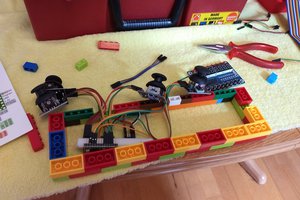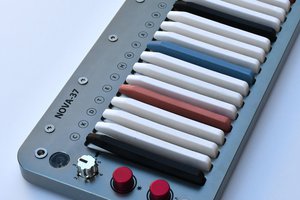This project comprises 3 Arduino-based MIDI controllers - an augmented Korg MicroKey 61 note keyboard with added Vibe Bar *, + 8 'Softpots', breath control & an input for a continuous pedal & 2 switches.
The Claude Controller (Mk 3)- an array of 74 wheels , 2 X/Y joysticks, one 500mm 'Softpot' & 15 switches arranged in a keyboard-like layout for controlling all the parameters of a synthesizer and associated FX.
The Loopatron (Mk 2) - an array of switches arranged like a keyboard. Each 'key 'comprises 3 switches - one for note on/off, one for note on only (latch) and one for note off only.
My reasons for the project:
Today’s synthesizers (real or software based) can produce any imaginable sound. But like acoustic instruments or the voice, musical sound needs to constantly change in timber to touch the heart. At present I don’t see this happening a lot in current electronic music practices – partly due to design limitations of the instruments and also there hasn’t been a standard interface to teach synthesizer performance.
Electronic music technology today is amazing but the control of the sound, which is so important for expression, hasn’t changed much since the 70’s. Everything is controlled by a ‘sea of knobs’. There are 2 problems with this approach. (1) It takes a whole hand to move 1 knob making simultaneous real time control of multiple parameters difficult and (2) There is no standard layout so you have to learn a new technique for each new piece of gear.
I have developed a much more ergonomic system and can also be a uniform way of teaching the synthesizer.
The Claude Controller that takes all the synth and FX parameters and via MIDI lays them out in a keyboard-like pattern (2 banks of 3 octaves). Instead of knobs, my system uses vertical ‘wheels’, which means it becomes possible to ‘play’ the controls much like you play the keyboard. The main advantages being:
(1) Each finger can independently articulate a parameter so 5 are possible with one hand, allowing incredible expressive nuance.
(2) The keyboard-like layout is a familiar pattern for locating particular controls at a glance and can be used as a ‘standard’ for all MIDI setups now and into the future – want more controls, add more ‘octaves’.
(3) It would be possible to notate parameter changes using more or less standard music notation! This has never been possible before which has limited composers in the field.
* The Vibe Bar – a controller attached to the MIDI keyboard for adding pitch bend & vibrato (a part of almost all acoustic instrument expression),
 Claude Woodward
Claude Woodward

 jonHickam
jonHickam

 Peggy, Keith and Petyr
Peggy, Keith and Petyr
Hey there, I'm keen to follow along with this project - will you be posting any build details? In particular I'm fascinated by the Claude Controller, as I looked into doing something similar using MIDIBox boards a while back.